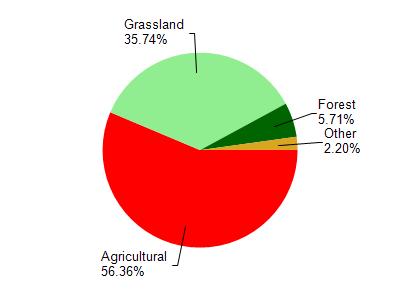Lafayette
No
No
No
Fish and Aquatic Life
Overview
After the confluence of the North and South Branches, the Ames Branch flows easterly to the West Fork of the Pecatonica River. It is a rather low gradient, warm water sport fishery with limited smallmouth bass and channel catfish populations (2001 baseline). Cropland erosion and grazing have caused habitat degradation and low dissolved oxygen concentrations. Periodic fish kills have occurred in the stream in 1983, 1991, and 1994. The reason for the kills was not documented. The North Fork contributes approximately one-sixth of the flow of Ames Branch. Although classified along with the main branch as a warm water sport fishery, it mainly harbors forage fish due to its low volume of flow. The South Fork is similar in nature. Smallmouth bass populations have decreased in the Ames branch, but this is a trend throughout the region.
Date 2002
Author Aquatic Biologist
Historical Description
Ames Branch, T2N, R3E, Sections 12-15, Surface acres = 26.7, Miles = 9.6, Gradient = 19.8 feet per mile, Total alkalinity = 281 mg/l, Volume of flow = 13.0 cfs.
Ames Branch flows easterly to the West Fork of the Pecatonica River. It is a rather low gradient, warm water stream which commonly floods during periods af high runoff. The lower portion of this stream is managed for smallmouth bass and channel catfish. The upper half of the stream furnishes suitable habitat for forage species only, and all feeder streams are managed for forage fishes. Over 90 percent of the land area in the watershed is considered agricultural with much of the high land under the plow and the level valleys in meadow or firm pasture. The majority of the stream bottom consists of gravel and rubble with silt near the mouth. Game assets include some waterfowl nesting and furbearer habitat which are limited due to lack of adjoining wetlands. Access points consist of six bridge crossings which appear to be adequate for tile resource at the present time.
From: Piening, Ronald; Poff, Ronald; Threinen, C.W., 1967. Lake and Stream Classification Project. Surface Water Resources of Lafayette County, Wisconsin Department of Natural Resources, Madison, WI.
Date 1967
Author Surface Water Inventory Of Wisconsin
General Condition
Ames Branch was assessed during the 2018 listing cycle; new biological (fish Index of Biotic Integrity (IBI) scores) sample data were clearly below the 2018 WisCALM listing thresholds for the Fish and Aquatic Life use. This water was meeting this designated use and was not considered impaired.
Date 2017
Author Ashley Beranek
Condition
Wisconsin has over 84,000 miles of streams, 15,000 lakes and milllions of acres of wetlands. Assessing the condition of this vast amount of water is challenging. The state's water monitoring program uses a media-based, cross-program approach to analyze water condition. An updated monitoring strategy (2015-2020) is now available. Compliance with Clean Water Act fishable, swimmable standards are located in the Executive Summary of Water Condition in 2018. See also the 'monitoring and projects' tab.
Reports
Management Goals
Wisconsin's Water Quality Standards provide qualitative and quantitative goals for waters that are protective of Fishable, Swimmable conditions [Learn more]. Waters that do not meet water quality standards are considered impaired and restoration actions are planned and carried out until the water is once again fishable and swimmable
Management goals can include creation or implementation of a Total Maximum Daily Load analysis, a Nine Key Element Plan, or other restoration work, education and outreach and more. If specific recommendations exist for this water, they will be displayed below online.
Monitoring
Monitoring the condition of a river, stream, or lake includes gathering physical, chemical, biological, and habitat data. Comprehensive studies often gather all these parameters in great detail, while lighter assessment events will involve sampling physical, chemical and biological data such as macroinvertebrates. Aquatic macroinvertebrates and fish communities integrate watershed or catchment condition, providing great insight into overall ecosystem health. Chemical and habitat parameters tell researchers more about human induced problems including contaminated runoff, point source dischargers, or habitat issues that foster or limit the potential of aquatic communities to thrive in a given area. Wisconsin's Water Monitoring Strategy was recenty updated.
Grants and Management Projects
| Project Name (Click for Details) | Year Started |
|---|
|
|
Monitoring Projects
| WBIC | Official Waterbody Name | Station ID | Station Name | Earliest Fieldwork Date | Latest Fieldwork Date | View Station | View Data |
|---|
| 921200 | Ames Br | 10008181 | Ames Branch Station 3-Near Wood Rd | | | Map | Data |
| 921200 | Ames Br | 10040912 | Ames Branch at Ames Road | 8/7/2013 | 1/1/2015 | Map | Data |
| 921200 | Ames Br | 10008180 | Ames Branch Station 2-(Rocky Road) | | | Map | Data |
| 921200 | Ames Br | 10008177 | Ames Br - Ames Branch Station 1 | 11/9/2001 | 11/9/2001 | Map | Data |
|

Watershed Characteristics
Ames Br is located in the Middle Pecatonica River watershed which is 186.42 mi². Land use in the watershed is primarily agricultural (56.30%), grassland (35.70%) and a mix of forest (5.70%) and other uses (2.20%). This watershed has 484.82 stream miles, 27.78 lake acres and 298.28 wetland acres.
Nonpoint Source Characteristics
This watershed is ranked Not Ranked for runoff impacts on streams, Not Ranked for runoff impacts on lakes and High for runoff impacts on groundwater and therefore has an overall rank of High. This value can be used in ranking the watershed or individual waterbodies for grant funding under state and county programs.This water is ranked High Stream for individual Rivers based on runoff problems and the likelihood of success from project implementation.